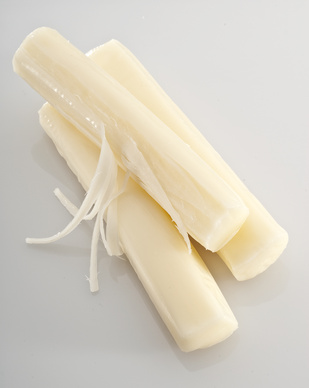One of the greatest differences for wide or coarse hair vs. fine hair is an element of flexibility. In cosmetics science, it is sometimes called plasticity.
Oils, conditioning agents like cationic quaternary surfactants, fatty alcohols like cetyl alcohol and “butters” like shea butter, oils and silicones all add plasticity to hair. So might proteins, amino acids and humectants by promoting good hydration.
When we think “plastic” in everyday life, we usually think of hard or semi-hard plastic boxes and containers. But in biology, physics and engineering, “plasticity” means an object has flexibility, it can be molded and is pliable. In this post, I suggested that one of the frustrating issues for fine hair is that it can have an excess of plasticity – it is very easily deformed.
Hair which is coarse (wider hair shaft), resists changing shape. It is not as super-flexible as fine hair. So fine / medium hair and coarse hair are fibers with different behavior and different needs. Fundamentally, they are made from the same ingredients, but the expression of the ingredients is different.
If hair is lower in plasticity/flexibility, it is difficult to change it’s shape – hard to curl straight hair, hard to straighten curly hair. It will behave differently in a variety of situations and to a variety of treatments. It may take extra effort to get coarse hair with a wave or curl pattern to lie smoothly, which is a prerequisite for shine.
 |
| Medium to wide hair resists bending, rather more like coiling up a garden hose. |
Coarse hair has more internal support than fine hair. It holds its own shape quite well, it is less likely to be weighed down. You can see in the graphic (below) how much more brown (hair cortex) there is with a wider hair than a narrower (fine) hair. This is why wider hairs are less pliable. These unrealistically round hair sketches were easier to do with the software I was using when this post was written. Hair is usually oval to elliptical in cross section. I like to imagine fine hair like trying to wind or coil up a cotton rope and wide/coarse hair like coiling up a garden hose, which resists the bending and tends to want to coil in it’s usual pattern.
 |
| See notes to the right. I know - hair is elliptical. But this is easier for me to "draw!" |
In the fine hair post, this visual aid represented the problem of how much more conditioner or oil clings to fine hair vs. wider hairs, relative to the mass or volume of the interior of the hair. It works the other way around for wider hairs – plenty of conditioner is needed to make this hair type feel soft and smooth and bendable because the conditioner contacts so much less of the whole of the hair.
Plasticizers in hair work like lotion or cream on dry skin – soften, seal in moisture, or attract moisture. They also add an element of pliability and flexibility (plasticity) that the hair may not have on its own. Like oiling leather or polishing a dry leather shoe, something inflexible becomes flexible, softer and glossier with the addition of a plasticizer (oil or shoe polish).
©Science-y Hair Blog 2013
If you have ever used a leave-in conditioner, smoothed coconut oil or avocado into your hair, left in a lot of conditioner – and had your hair become softer, springier, better defined as a result – you can chalk that up to the increase in plasticity/flexibility.
And if you want your hair to have more pliability, you need emollients (oil or conditioner) – not only to act as an occlusive (prevent moisture loss because hair + water = flexibility), but also to help your hair stay soft and to align itself with its neighbors which increases shine and wave/curl definition.
If your hair has kinking in it, the added plasticity of oils and conditioners also helps prevent breakage. Each little bend and twist of the fiber (kink) can be a point of weakness in the fiber. The more abrupt a directional change, the weaker that spot is.
©Science-y Hair Blog 2013
Here’s a final thought. If you have fine hair, which is dry or porous or damaged, it may act like wider hairs and need more plasticity too, but fine-haired people can usually get away with much less.
Some parting thoughts: Usually you can tell if you have coarse hairs. They feel solid between your fingers. You can see them easily when held up against a contrasting background. When you bend coarse hairs, they like to spring back. Some coarse hair is quite pliable and bendable, some feels more rigid and wiry. Especially when hair is light-colored or not thick (densely packed) on your head or it is soft - it may not seem coarse when it actually is. It is a myth that all coarse hair is rigid or feels wiry. Coarse hair can be slippery and silky or springy and soft, or wiry.
Some parting thoughts: Usually you can tell if you have coarse hairs. They feel solid between your fingers. You can see them easily when held up against a contrasting background. When you bend coarse hairs, they like to spring back. Some coarse hair is quite pliable and bendable, some feels more rigid and wiry. Especially when hair is light-colored or not thick (densely packed) on your head or it is soft - it may not seem coarse when it actually is. It is a myth that all coarse hair is rigid or feels wiry. Coarse hair can be slippery and silky or springy and soft, or wiry.

